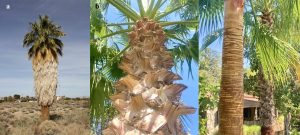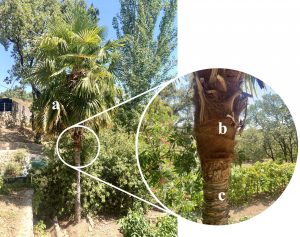Although many palm trees shed their palms (leaves), which is convenient for their gardener or owner, leaving a smooth stipe (trunk) with visible leaf scars as they grow, others keep their dead palms hugging the stipe. These palms, in their natural state, typically create a skirt of dry leaves at the base of the crown.

The most commonly planted plam trees in gardens in Europe are among the latter: Washingtonia, which wild individuals form imposing skirts that represent an ideal fuel in case of fire, Trachycarpus, which creates an intricate mesh of brown fibers in the sheath of the leaf, very characteristic, and some Phoenix. In gardening, the maintenance and care of ornamental palm species that form skirts is essential for several reasons that go beyond mere aesthetics and concern comfort and safety in the private or public gardens. In Palmer Brothers we provide these services in our region (see ‘Services‘).

1- Aesthetics:
Obviously, the first reason for pruning and skinning the stipes of ornamental palm trees is aesthetic. A dirty stipe covered by a coarse layer of dry and dead leaves does not look as good as an elongated and clean stipe, with foliar scars forming beautiful regular rings or diamond-shaped rhombuses witnessing the gradual growth of the plant. Of course, there is nothing prettier than a slender, tall palm tree, which surprises with its leafy green crown with large leaves culminating in a fine and flexible column that makes it more stylized. However, there are other reasons why those who have a palm tree should keep it clean.
2- Fire hazard:
Dried palms, and especially the sheath fibers, are surprisingly flammable. In fact, many of the palm trees that do not shed their leaves naturally do so because they are pyrophiles, i.e., under natural conditions they benefit from fire, since they get rid of neighboring plant competitors, and therefore they promote fire by producing fuel. This advantage for the plant in its natural habitat represents a danger in our garden, especially in places and times of the year with high fire hazard. Pruning and skinning ornamental palm trees is necessary for safety reasons, to prevent possible fires from starting or spreading easily in the garden.
3- Danger due to falling leaves:
The palms are often very large and heavy, and are can be armed with very sharp spines and hooks. Therefore, they represent a danger for walkers and onlookers who come to enjoy an imposing palm tree. Sometimes, especially due to the action of the wind or the activity of some animal, palm trees can end up pulling some of their dry leaves from their skirt. If one of these leaves falls on a person or pet, it can cause serious injury. Pruning the leaves (and, in this case, not necessarily skinning) is a safety practice to avoid this type of incident.
4- Niche for unwanted fauna:
The dense tangles of dry leaves that accumulate under the canopy of the palm tree are the ideal place to settle for multitudes of insects, rodents, and birds. Palm skirts are sheltered from predators, protected by thorns, shady, cool, and often retain a surprising amount of moisture even in the driest times of the year. Of course–and this is not ironic–if you want to increase the biodiversity of wildlife in your garden, letting your palm trees to form skirts can help. However, if you don’t want rats and mice, spiders, wasps and ants to proliferate around your palm tree, you’d better prune and skin it regularly.
